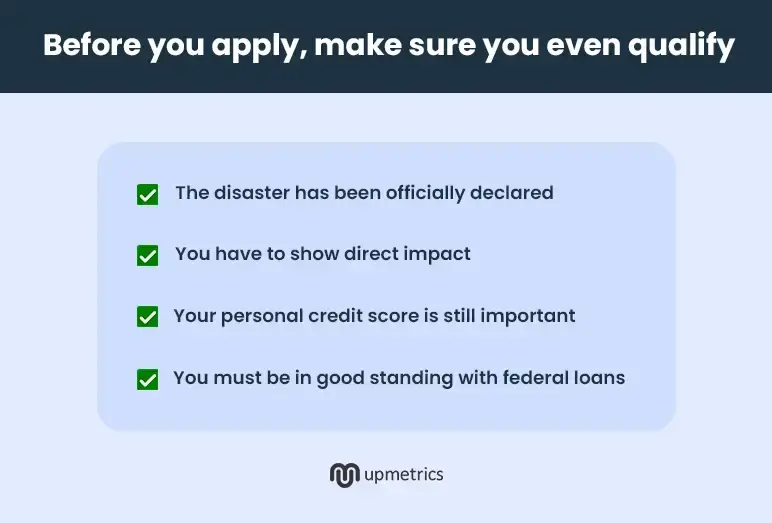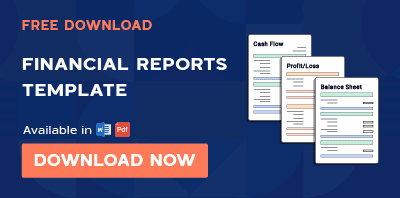You’d think the SBA disaster loan process would be simple—apply, explain your situation, get help.
It’s not.
They’ll review your credit. Check your business history. Scan every line of your paperwork. If something looks off, they won’t ask questions. They simply reject it saying NO.
I’ve seen founders lose weeks just because a number didn’t match across two forms.
So, if you want to do this right, don’t guess your way through how to apply for an SBA disaster loan.
Let’s see what the SBA will actually be looking at and how to avoid mistakes that slow things down or get you denied altogether.
Because “submitted” doesn’t mean “approved.”
Before you apply, make sure you even qualify
You’d be surprised how many founders rush into the application for SBA loans, thinking their business automatically qualifies…
They assume that if their business is struggling, they qualify. So they apply, upload all their info, and wait.
Then, weeks go by, and the denial hits.
Why? Because they didn’t meet the core requirements in the first place.
The SBA screens for that upfront.
If you don’t pass their first few checks, nothing else matters. And right at the top of their checklist is confirming…

✅ The disaster has been officially declared
The disaster has to be on the SBA’s radar, not just something your business struggled through.
That means your location must be tied to a federally declared disaster. You can quickly confirm it on the FEMA website.
If your area isn’t listed, your application won’t move forward.
✅You have to show direct impact
It’s not enough to say your business is suffering.
The SBA wants proof that the disaster caused it. They’ll compare your revenue from before and after the event.
If the financial dip started long before the event, or if it’s tied to unrelated issues, that’s usually a dealbreaker.
✅Your personal credit score is still important
Your personal credit score is part of the decision, even if your business is incorporated or registered as an LLC.
If it’s under 570, the SBA sees that as high risk.
They won’t reach out or give you a chance to explain. They just flag it and move on.
✅You must be in good standing with federal loans
You need a clean record of federal debt because the SBA checks your history with loans. If you’ve ever defaulted on a government-backed loan like a student loan or a previous SBA loan, that’s going to hurt you.
Even if it’s years back, it stays in their system.
That kind of red flag usually ends the review right there.
If you’re still reading and you meet all the basic rules, that’s a good start.
Now, you’ve got to back it up with accurate documentation. Because as far as the SBA’s concerned…
If your paperwork is a mess, you’re already out.
The SBA doesn’t need perfection, but they do require consistency.
If the numbers on your tax return don’t match your profit and loss statement or a form is half-filled, they’re not reaching out to clarify. They’ll reject your application.
So, what documents do I need for an SBA disaster loan?
Make sure you’ve got:
- Two years of personal and business tax returns
- SBA Form 413 for personal financials
- Proof of business registration
- Monthly revenue breakdown showing clear disaster impact
- Profit and loss statement
- SBA Form 2202 listing business debts
SBA wants the numbers to make sense. If something’s missing or inconsistent, they’re not sorting it out for you.
So, before you hit submit, do one last check. Because even if your docs are solid, what you put into the actual form still matters—and that’s where most people slip up.
Filling out the form isn’t hard. Getting it right is.
The SBA disaster loan form isn’t long, and it’s not tricky. Most founders complete it in under 30 minutes. But that’s precisely why mistakes happen—because people assume it’s a formality.
It’s not. What you write here has to match the documents you have already prepared. If anything’s off, the SBA isn’t going to fix it for you.
You’ll find the SBA loan application form on the SBA Disaster Loan Assistance Portal. Then, create an account, work through the form step by step, and submit everything from the same portal.
Business legal information
You’ll need to list your business name exactly as registered, your EIN, business structure (LLC, sole prop, etc.), and NAICS code (industry classification).
Picking the wrong NAICS code. You can find the correct one using the NAICS search tool.
Financial details
The form will ask for your business’s gross revenues and cost of goods sold (COGS) for the 12 months leading up to the disaster. It should match your tax return or profit and loss statement exactly.
Rounding off numbers or estimating. If your tax return says $187,490, don’t put $190,000 on the form. That kind of mismatch gets flagged.
Ownership breakdown
You’ll need to list all owners who have 20% or more stake in the business, along with their Social Security numbers, addresses, and ownership percentages.
People forget to update their ownership records or list owners who no longer have a stake. Whatever you put here should match your business registration documents.
Insurance coverage and disaster impact
They’ll ask if you have any insurance that could cover losses—property, business interruption, etc. Be honest here. If you’re covered, say so. If not, explain briefly.
Background and loan history
You’ll answer yes/no questions about past criminal history and whether you’ve ever defaulted on a government loan. These answers should match what’s already on file with federal systems.
The form itself is simple. But if what you enter doesn’t match your documents or you leave fields blank, thinking they’re optional, you’re setting yourself up for a rejection.
So don’t treat this like busy work. This is what decides if your file even gets a second look. Get it right.
If you’re unsure how to present your financials or make your numbers more manageable to follow, use a business planning tool like Upmetrics. It helps you build a business plan that’s actually lender-friendly—with precise projections, breakdowns, and funding use cases that match what SBA reviewers look for.
But once you hit “submit,” don’t go dark.
Submitting your SBA disaster loan application isn’t the finish line. It’s the start of a waiting period, and if you go quiet now, you might miss important updates that affect your approval.
First, you’ll get a confirmation email with your application number. Save it.
Then, the review process usually takes 2–4 weeks, sometimes longer if there’s a high volume or missing info.
You won’t always get a heads-up if the SBA needs clarification. Most follow-ups happen inside the portal. So, keep checking your account. If the SBA asks for anything—a corrected document or a quick explanation and you don’t respond in time, your application could stall or get denied.
Also, don’t make changes to your financials or ownership while your application is under review unless they are essential. If something does change, report it clearly and quickly.
You don’t need to hover. But don’t disappear, either. Stay logged in, stay reachable, and be ready to reply fast if the SBA asks for anything. Because…
If you’re going to apply, apply like it is the most important thing for your business.
Because for a lot of businesses, it is.
The most common mistakes are preventable. And fixing those before you apply saves weeks you don’t have to waste.
So, if you’re applying, do it like you’re expecting them to say yes.
The closer your file is to lender readiness, the fewer questions it raises and the faster it moves through the system.
And if you’re stuck, ask for help. Use a tool. Talk to someone who’s done it before. The application is your case for why funding makes sense.
If that sounds overwhelming, SBA lending assistance by Upmetrics can help. Their team reviews your business plan, makes it lender-ready, and connects you directly with trusted SBA lenders. You’ll save time, avoid guesswork, and approach the process with confidence.
The Quickest Way to turn a Business Idea into a Business Plan
Fill-in-the-blanks and automatic financials make it easy.


